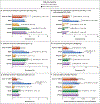Implications of Race Adjustment in Lung-Function Equations
- PMID: 38767252
- PMCID: PMC11305821
- DOI: 10.1056/NEJMsa2311809
Implications of Race Adjustment in Lung-Function Equations
Abstract
Background: Adjustment for race is discouraged in lung-function testing, but the implications of adopting race-neutral equations have not been comprehensively quantified.
Methods: We obtained longitudinal data from 369,077 participants in the National Health and Nutrition Examination Survey, U.K. Biobank, the Multi-Ethnic Study of Atherosclerosis, and the Organ Procurement and Transplantation Network. Using these data, we compared the race-based 2012 Global Lung Function Initiative (GLI-2012) equations with race-neutral equations introduced in 2022 (GLI-Global). Evaluated outcomes included national projections of clinical, occupational, and financial reclassifications; individual lung-allocation scores for transplantation priority; and concordance statistics (C statistics) for clinical prediction tasks.
Results: Among the 249 million persons in the United States between 6 and 79 years of age who are able to produce high-quality spirometric results, the use of GLI-Global equations may reclassify ventilatory impairment for 12.5 million persons, medical impairment ratings for 8.16 million, occupational eligibility for 2.28 million, grading of chronic obstructive pulmonary disease for 2.05 million, and military disability compensation for 413,000. These potential changes differed according to race; for example, classifications of nonobstructive ventilatory impairment may change dramatically, increasing 141% (95% confidence interval [CI], 113 to 169) among Black persons and decreasing 69% (95% CI, 63 to 74) among White persons. Annual disability payments may increase by more than $1 billion among Black veterans and decrease by $0.5 billion among White veterans. GLI-2012 and GLI-Global equations had similar discriminative accuracy with regard to respiratory symptoms, health care utilization, new-onset disease, death from any cause, death related to respiratory disease, and death among persons on a transplant waiting list, with differences in C statistics ranging from -0.008 to 0.011.
Conclusions: The use of race-based and race-neutral equations generated similarly accurate predictions of respiratory outcomes but assigned different disease classifications, occupational eligibility, and disability compensation for millions of persons, with effects diverging according to race. (Funded by the National Heart Lung and Blood Institute and the National Institute of Environmental Health Sciences.).
Copyright © 2024 Massachusetts Medical Society.
Figures


Comment in
-
Routine baseline spirometry for everyone?Medicina (B Aires). 2024;84(6):1294-1296. Medicina (B Aires). 2024. PMID: 39666436 English. No abstract available.
References
-
- Kaminsky DA. Selecting reference values for pulmonary function tests. Philadelphia: UpToDate, 2023. (https://www.uptodate.com/contents/selecting-reference-values-for-pulmona...).
-
- Stanojevic S, Kaminsky DA, Miller MR, et al. ERS/ATS technical standard on interpretive strategies for routine lung function tests. Eur Respir J 2022; 60: 2101499. - PubMed
-
- Global Initiative for Chronic Obstructive Lung Disease. Global strategy for the prevention, diagnosis and management of COPD: 2023 report. 2023. (https://goldcopd.org/2023-gold-report-2/).
-
- Vyas DA, Eisenstein LG, Jones DS. Hidden in plain sight — reconsidering the use of race correction in clinical algorithms. N Engl J Med 2020; 383: 874–82. - PubMed
-
- Braun L Breathing race into the machine: the surprising career of the spirometer from plantation to genetics. Minneapolis: University of Minnesota Press, 2014.
Publication types
MeSH terms
Grants and funding
LinkOut - more resources
Full Text Sources
Medical
